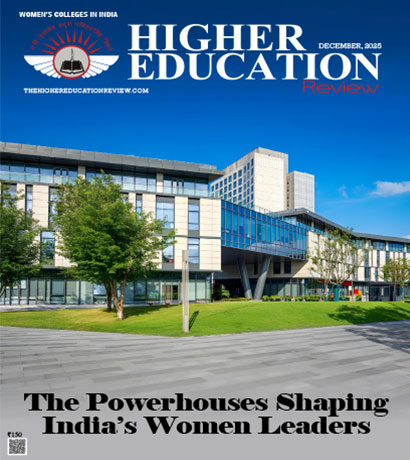Harnessing the Untapped Potential of Emerging Technologies in Education
 Balkishan Sharma is a paragon of visionary leadership and academic eminence. He co-founded and directed the Future Varsity Education Group with a strategic eye toward innovation. Sharma's scholarly journey is distinguished by an M.B.A. and a Ph.D., reflecting his dedication to lifelong learning. An illustrious alumnus of IIM Ahmedabad and ISB Executive Education Hyderabad, his educational pedigree is synonymous with profound business acumen. As the founder and director of the American Global School, Sharma has been instrumental in shaping the educational landscape and fostering a global outlook among future leaders.
Balkishan Sharma is a paragon of visionary leadership and academic eminence. He co-founded and directed the Future Varsity Education Group with a strategic eye toward innovation. Sharma's scholarly journey is distinguished by an M.B.A. and a Ph.D., reflecting his dedication to lifelong learning. An illustrious alumnus of IIM Ahmedabad and ISB Executive Education Hyderabad, his educational pedigree is synonymous with profound business acumen. As the founder and director of the American Global School, Sharma has been instrumental in shaping the educational landscape and fostering a global outlook among future leaders.
In the ever-evolving landscape of education, emerging technologies are playing a pivotal role in shaping the future of learning. These technologies have the potential to completely change the way education is delivered, by improving accessibility, individualization, and effectiveness. These technologies, which range from blockchain and mobile learning to artificial intelligence and virtual reality, are revolutionizing traditional classrooms into dynamic, interactive learning spaces. This article explores these innovations' revolutionary potential and how to use them to open up new horizons in education.
Personalised Learning Experiences
One of the most significant impacts of technology in education is the ability to create personalised learning experiences. Artificial Intelligence (AI) and Machine Learning (ML) algorithms can analyse a student's learning patterns, strengths, and weaknesses to customise educational content accordingly. This bespoke approach ensures that each learner receives instruction that is best suited to their individual needs, thereby enhancing understanding and retention.
Virtual and Augmented Reality
Virtual Reality (VR) and Augmented Reality (AR) have introduced immersive learning experiences that were once the content for science fiction. With the use of these tools, instructors can take their students to virtual settings where they can engage directly with difficult ideas. With the use of VR and AR, learning can be made more interesting and dynamic by performing activities such as dissecting a virtual human body and exploring the expanse of space.
Blockchain in Credentialing
Managing educational certificates is made easy with the secure and unchangeable ledger system that blockchain technology provides. With blockchain, academic records and certifications can be stored in a tamper-proof format, easily verifiable by employers and educational institutions. This gives students more control over their academic performance while also streamlining the credential verification procedure.
The Internet of Things (IoT)
By linking actual objects to the internet, the Internet of Things (IoT) creates a network of intelligent teaching resources. IoT gadgets can help with lab work, monitor classroom conditions, and even track attendance. Through the integration of IoT into the classroom, instructors can collect useful data to enhance their teaching strategies and establish a supportive learning environment.
Enhanced Inclusivity and Accessibility
New educational technologies have the power to remove obstacles to learning. It increases access to educational opportunities and resources for students across the country, including those from underprivileged communities or to students with disabilities. Features that support various learning styles and preferences, such as text-to-speech, closed captioning, and adaptable learning platforms, promote inclusivity and give all students the tools they need to succeed.
Cloud powered education
The advent of cloud computing has completely transformed the field of educational infrastructure and resources by providing unrestricted access to large databases, software, and computer power. Cloud-based systems support collaborative learning environments by enabling teachers and students to share resources, collaborate on projects, and access software from any web-connected device. In addition, cloud-based virtual labs and simulations offer affordable alternatives to traditional lab equipment, balancing the supply of chances for hands-on STEM instruction.
Big Data Analytics
Big data analytics enables educators to make informed decisions based on vast amounts of educational data. Institutions can forecast student performance, pinpoint areas for improvement, and personalize curriculum by examining trends and patterns. The alignment of educational programs with industry objectives and student requirements is ensured by this data-driven approach.
Global cooperation and Cultural Exchange
By bridging geographical boundaries between students and educators, emerging technologies promote global cooperation and cultural exchange. With the help of digital communication platforms, online collaboration tools, and virtual classrooms, students may work together on projects, engage in cross-cultural interactions, and learn from a variety of viewpoints and experiences, all of which will help them succeed in a globalized society.
Challenges and Considerations
Emerging technologies have a lot of potential, but there are also a lot of obstacles to take into account. One major obstacle is the digital divide, which causes differences in educational opportunities due to unequal access to technology. Another is data security and privacy, which is crucial because student data must be collected and analysed with extreme caution to protect individual rights. Furthermore, putting new technologies into the classroom and keeping them up to date can be expensive, requiring investments in infrastructure, software, hardware, and technical support. Schools and districts, especially those serving underprivileged communities, may find it difficult to implement and maintain cutting-edge technological programs due to a lack of funds.
There are several ways that emerging technologies might improve education. We can build a learning ecosystem that is more effective, individualised, and inclusive by utilising these advancements. To guarantee that all students can benefit from technology, it is necessary to carefully manage the obstacles. In addition to embracing these tools, we need to promote a culture of lifelong learning and flexibility so that students are equipped for both the problems of the future and the occupations of the present.

